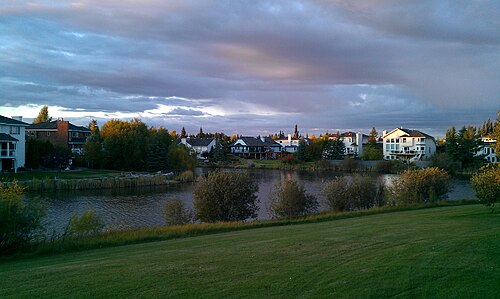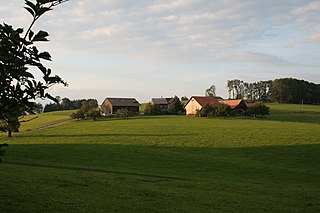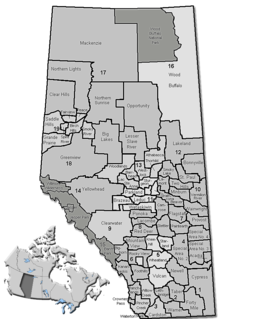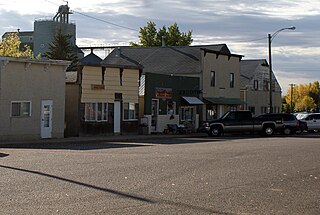| ||
 Distribution of Alberta's 269 urban municipalities | ||
Alberta has provincial legislation allowing its municipalities to conduct municipal censuses between April 1 and June 30 inclusive. [1] [2] Municipalities choose to conduct their own censuses for multiple reasons such as to better inform municipal service planning and provision, to capitalize on per capita based grant funding from higher levels of government, or to simply update their populations since the last federal census. [3]

Alberta is a western province of Canada. With an estimated population of 4,067,175 as of 2016 census, it is Canada's fourth most populous province and the most populous of Canada's three prairie provinces. Its area is about 660,000 square kilometres (250,000 sq mi). Alberta and its neighbour Saskatchewan were districts of the Northwest Territories until they were established as provinces on September 1, 1905. The premier has been Rachel Notley since May 2015.
Four provinces and territories in Canada have legislation that allow municipalities to conduct a municipal census. These include the provinces of Alberta and Saskatchewan and the territories of Nunavut and Yukon. Of these four provinces and territories, municipalities in Alberta were the only ones that exercise the option to conduct a municipal census as of 2006.

A census is the procedure of systematically acquiring and recording information about the members of a given population. The term is used mostly in connection with national population and housing censuses; other common censuses include agriculture, business, and traffic censuses. The United Nations defines the essential features of population and housing censuses as "individual enumeration, universality within a defined territory, simultaneity and defined periodicity", and recommends that population censuses be taken at least every 10 years. United Nations recommendations also cover census topics to be collected, official definitions, classifications and other useful information to co-ordinate international practice.
Contents
- Municipal census results
- Breakdowns
- Lloydminster
- Urban and rural service areas
- Hamlets
- Shadow population counts
- Notes
- See also
- References
- External links
Alberta had 357 municipalities between April 1 and June 30, 2015, which marked the closure of the 2015 legislated municipal census period. This was reduced to 356 on July 1, 2015 when the former Village of Minburn dissolved to become a hamlet under the jurisdiction of the County of Minburn No. 27. At least 52 of these municipalities (14.6%) conducted a municipal census in 2015. Alberta Municipal Affairs recognized those conducted by 50 of these municipalities. [4] By municipal status, it recognized those conducted by 12 of Alberta's 18 cities, 20 of 108 towns, 5 of 92 villages, 3 of 5 specialized municipalities, 2 of 64 municipal districts, and all 8 Metis settlements. [4] [lower-alpha 1] In addition to those recognized by Municipal Affairs, censuses were conducted by the villages of Kitscoty and Warburg. [5] [6]

Events from the year 2015 in Canada.

Minburn is a hamlet in central, Alberta, Canada within the County of Minburn No. 27. It is located on the Yellowhead Highway and the Canadian National Railway, approximately 37 km (23 mi) west of the Town of Vermilion and 143 km (89 mi) east of the City of Edmonton.

The County of Minburn No. 27 is a municipal district in east central Alberta, Canada. Its municipal office is located in the Town of Vegreville. Located in Census Division 10, the County of Minburn No. 27 was formed as a county on January 1, 1965 from the former Municipal District of Minburn No. 72.
Some municipalities achieved population milestones as a result of their 2015 censuses. Red Deer became the third city in Alberta to exceed 100,000 residents, while Grande Prairie not only surpassed 60,000 people, but also overtook both St. Albert and Medicine Hat to become Alberta's fifth-largest city. Spruce Grove grew beyond the 30,000 mark, while both the Town of Blackfalds and the County of Vermilion River eclipsed 8,000. The Town of Westlock's population resurfaced above 5,000 after first doing so in 2006 but dropping back below in 2008. The Village of Thorsby surpassed 1,000, making it eligible to apply for town status.
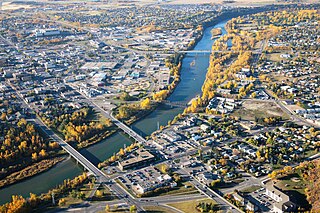
Red Deer is a city in Central Alberta, Canada. It is located near the midpoint of the Calgary–Edmonton Corridor and is surrounded by Red Deer County. It is Alberta's third-most-populous city – after Calgary and Edmonton. The city is located in aspen parkland, a region of rolling hills that is home to oil, grain, and cattle production. It is a centre for oil and agriculture distribution, and the surrounding region is a major centre for petrochemical production. Red Deer had a population of 100,418 as of the Canada 2016 census making Red Deer Alberta's third city to surpass 100,000 people.

Grande Prairie is a city in northwest Alberta, Canada within the southern portion of an area known as Peace River Country. It is located at the intersection of Highway 43 and Highway 40, approximately 456 km (283 mi) northwest of Edmonton. The city is surrounded by the County of Grande Prairie No. 1.

St. Albert is a city in Alberta, Canada, on the Sturgeon River northwest of the City of Edmonton. It was originally settled as a Métis community, and is now the second-largest city in the Edmonton Metropolitan Region. St. Albert first received its town status in 1904 and was reached by the Canadian Northern Railway in 1906.

